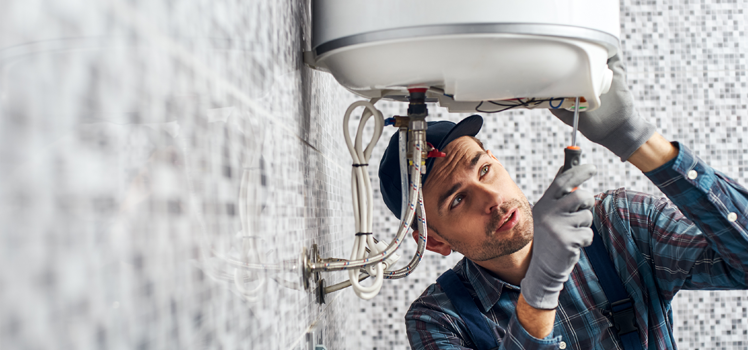Following our popular article on how to prevent your pipes from freezing, we thought you might like an advanced heads up on how to prepare your boiler for the winter.
What boiler do you have?
To prepare your boiler for the winter, we firstly need to understand what type of boiler / heating system you have in the property.
There are 2 main types of heating systems:
1. A Combination Boiler System
2. A Conventional / Standard Central Heating System
But what’s the difference?
Combination Boiler System
A Combination Boiler System, or “Combi System”, heats water instantaneously whenever you turn on a hot tap, so you’ll never run out of hot water. In most cases, the temperature of the tap is dependent on the temperature of the mains supply and the flow rate, hence hot water performance is quoted in terms of litres per minute raised through 35 degrees C. It can take 2 – 3 times longer to fill up a bath full of hot water. Newer models of combination boilers have a small storage cylinder to help deliver higher flow rates.
The advantages of a Combination Boiler are:
- on demand hot water
- no storage tank in the loft
- less pipe work in the property
- requires a smaller amount of space
The disadvantages are:
- limited hot water temperature
- one tap operation
- no back up if the boiler stops working
- dependent on water mains pressure
Conventional or Standard Central Heating System
This type of boiler stores hot water in a hot water cylinder which is usually found in an airing cupboard. This hot water is used when you turn on the hot water tap. The system also stores cold water in a storage tank, usually found in your loft. The boiler heats this water which is then fed to the radiators keeping your house warm.
The advantages of a Conventional Heating System include:
- being able to use more than one tap at a time without affecting the water pressure
- an airing cupboard (handy to dry your towels in)
- an improved all-round water pressure
The main disadvantages of a Conventional Heating System is the fact that you do not have instant hot water. If your tank runs empty because someone else had a bath, you have to wait a while for the water to heat up again.
Condensing Boiler
A condensing boiler is the most efficient type of boiler because they extract the maximum amount of heat from the fuel burnt. A condensing boiler can operate at efficiency levels of over 90% by recovering and recycling heat that would otherwise be lost through the flue. Due to the the efficiency of the burning gas, they also produce less Carbon Dioxide, Nitrogen Dioxide and Sulphur Dioxide emissions.
If you wanted to cut your monthly spend and reduce the amount of gas emissions from your property, a high efficiency condensing boiler with heating controls will save you a fair amount of money and significantly reduce your home’s emissions.
Now we know a little about boilers, how can we make sure they are well maintained during winter?
How to prepare your boiler for winter
- To prepare your boiler for the winter, run your heating at least once a month, even in summer, to keep it running efficiently and clear the boiler pump of any grit that gathers when it’s not in use.
- Homeowners should get their boilers checked once a year by a Gas Safe Registered engineer to ensure it’s running both smoothly and safely.
- If you’re renting your home, it’s your landlord’s responsibility to get all gas appliances, including the boiler, inspected every year. By law they should provide you with a copy of their CP12 Gas Safety Certificate.
- For added safety, it’s a good idea to fit a Carbon Monoxide Detector to warn you if there’s a leak. If so, call the National Gas Emergency Service immediately on 0800 111 999.
- Never cover your gas boiler or block the air vents. Also, make sure the outside flues aren’t blocked.
Central heating troubles can be tricky to solve – especially in winter. If in doubt, call in a Gas Safe Register approved Heating Engineer for a safe repair.
Is your Gas Safety Certificate up for renewal? Sort it out today with LettingaProperty.com’s landlord services.
Prepare your boiler for winter by bleeding the radiators
Bleeding your radiators is a key part of preparing your boiler for the winter time. Trapped air prevents radiators heating up fully, so if your radiators feel cooler at the top than at the bottom, it’s likely that a bit of air has got stuck in them. Luckily, getting the air out of the radiator – “bleeding” – is as simple as it gets.
Step 1– First, switch off the circulation pump or just switch off the whole boiler, so there’s no chance of you getting splashed.
Step 2 – Each radiator has a bleed valve at one of its top corners, identifiable by a square bit in the middle of the round plug. They’re turned by specific keys which are easy enough to buy at any DIY shop if you can’t find them.
Step 3 – Use the key to turn the valve anticlockwise about a quarter of a turn. It shouldn’t be necessary to turn it further – but have a small container and a couple of rags handy to catch spurting water in case you open the valve too far.
Step 4 – You will hear a hissing sound as the air escapes. Keep the key on the shank of the valve, then when the hissing stops and the first dribble of water appears, close the valve tightly.
Step 5 – If no water or air comes out when you bleed the radiator, then the valve is probably blocked with paint. Close the inlet and outlet valve at each end of the radiator, then remove the screw from the centre of the bleed valve. Clear the hole with a piece of wire, and reopen one of the radiator valves slightly to eject some water from the hole. Close the radiator valve again and refit the screw in the bleed valve. Open both radiator valves and test the bleed valve again. Another job well done.



